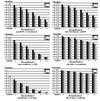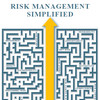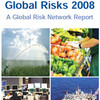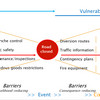 Opposites attract and in the supply chain world, “lean” and “agile” appear to be opposites. Both management strategies have their advantages and disadvantages, and the question is, is it possible for them to exist side by side, or even fuse? In their 2006 article A taxonomy for selecting global supply chain strategies, Christopher, Peck and Towill describe a fusion of Lean and Agile, termed LeAgile.
Opposites attract and in the supply chain world, “lean” and “agile” appear to be opposites. Both management strategies have their advantages and disadvantages, and the question is, is it possible for them to exist side by side, or even fuse? In their 2006 article A taxonomy for selecting global supply chain strategies, Christopher, Peck and Towill describe a fusion of Lean and Agile, termed LeAgile.
Where did leagile come from?
Christopher, Peck and Towill are not the first to use the term “leagile” . In fact, “leagile” has has been around for quite some time. Already in 1999, Naylor et al. published Leagility: Interfacing the Lean and Agile Manufacturing Paradigm in the Total Supply Chain, and since then, several authors have picked up on the subject. Legile comes from a synthesis of Lean manufacturing, which has a long history, and Agile manufacturing, which is considerably younger.
What does leagile mean?
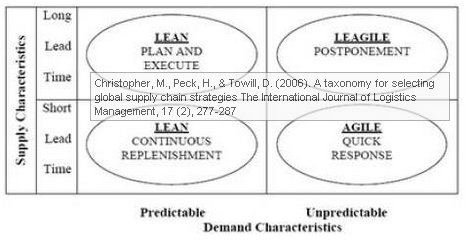
Copyright note: The figure above is taken from the article.
Leagile has emerged as an answer to the problem of reconciling long lead times with unpredictable demand. In a certain (predictable) world, going lean is fine, it is a cost-saver. However, when demand is uncertain, a company must retain its responsiveness vis-a-vis its customers. This is only possible if the supply chain is agile. But what if demand is unpredictable, while lead times are long, as they typically are in today’s global outsourcing? That is were leagile has a mission.
What does leagile have to do with supply chain risk?
Lean is often seen as one of the reasons why supply chains have become increasingly vulnerable, but that is only part of the story. Agility, on the other hand, is seen as a way to deal with, or rather, prepare for, supply chain disruptions. Agility is often mistaken for flexibility, but it is not. As I wrote in my post on robustness, resilience, flexibility and agility, using the definition in Goranson (1992) The Agile Virtual Enterprise:
flexibility is
scheduled or planned adaption to unforeseen yet expected external circumstances.
agility is
unplanned or unscheduled adaption to unforeseen and unexpected external circumstances.
So, is a lean supply chain more exposed to supply chain risk than an agile supply chain? I don’t think so, as I explained in my post Lean logistics = risky logistics?
Reference
Christopher, M., Peck, H., & Towill, D. (2006). A taxonomy for selecting global supply chain strategies The International Journal of Logistics Management, 17 (2), 277-287 DOI: 10.1108/09574090610689998
Christopher, M., & R.Towill, D. (2002). Developing Market Specific Supply Chain Strategies The International Journal of Logistics Management, 13 (1), 1-14 DOI: 10.1108/09574090210806324
Mason-Jones, R., Naylor, B., & Towill, D. (2000). Engineering the leagile supply chain International Journal of Agile Management Systems, 2 (1), 54-61 DOI: 10.1108/14654650010312606
Ben Naylor, J. (1999). Leagility: Integrating the lean and agile manufacturing paradigms in the total supply chain International Journal of Production Economics, 62 (1-2), 107-118 DOI: 10.1016/S0925-5273(98)00223-0
Author links
- cardiff.ac.uk: Professor Dennis Towill
- linkedin.com: Dr Helen Peck
- martin-christopher.info: Professor Emeritus Martin Christopher
- linkedin.com: Dr Rachel Mason-Jones
Related
- husdal.com: The Definition of Agility
- husdal.com: Book Review: Dynamic Supply Chain Management
- husdal.com: Lean logistics = Risky logistics?

